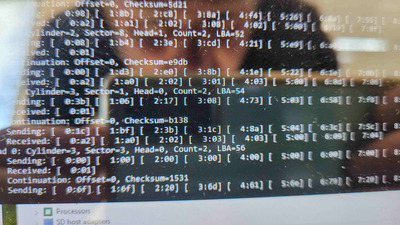Hi! This brings back some memories.
A Null-Modem is a Null Modem, right?
The 8250 UART was practically broken.
Sure, it could be made working. Software from the 1980s had workarounds built-in. Maybe carefully written assembler routines, don't know.
I remember the utility Ultrafast Filetransfer Operation , which could do 57600 or 115200 Baud on 8250/16450 era hardware over a 3-wire connection.
However, I don't know if XTIDE has such a workaround, too. It's from the 21th century, after all, long after the 16550A had become standard.
Maybe, the 8250 in that PS/2 can be upgraded? Without breaking BIOS compatibility?
The 16550A was pin compatible to the 16450, at least.
Not sure about the 8250, though. 🤷♂️
Here's another post of mine.
Sorry, I'm on a mobile device right now. Typing is cumbersome right now.
Re: Can I connect my IBM AT to a modern computer running dosbox?
Here are two virtual drives for DOS that connect over null modem.
One mentions explicit PS/2 compatibility.
Re: 386 , what can I do with it?
Good luck ! 🤞🙂
Edit: 9600 Baud might be a bit too high for a 8250 already!
Even for a 16450 with a functioning 1 Byte FiFo, it's almost borderline.
Please try 4800 Baud, too, if you can. Or 2400 Baud, if the processor can't catch up with it.
Edit: I know it sounds a bit contradictory.
Thing is, if the processor is fast enough, it can catch the incoming data in time, even without the help of a FiFo.
A fast 286 (16MHz up), a 386 or 486 processor might be able to archive better throughput on an 8250 or 16450.
So higher baud rates become possible.
However, on a slow 8086 or 286 (say 6MHz), the problem of missing characters might occur.
Edit: ^That's related to interrupts and polling, too.
Depending on how the system is running, a slow machine might be able to handle things.
A single DOS communications program that's running alone
and has full control over the PC might be able to do 115200 Baud on a Turbo XT.
Especially with the 7-wire connection and handshaking.
However, if multitasking comes into play, things look differently.
Other programs now will try to do claim interrupts, will steal processor time etc.
That's when buffering comes in handy. That's when the 16550A (or AF, C, AFN etc) is needed.
Edit: I've just checked the net if the 8250 could be directly replaced by a 16550A.
That's when Wikipedia came up with this article.
"Replacement of the factory-installed 8250 UART was a common upgrade for owners of IBM PC, XT, and compatible computers when high-speed modems became available.
Above 9600 baud, owners discovered that the serial ports of the computers were not able to handle a continuous flow of data without losing characters.
Exchange of the 8250 (having only a one-byte received data buffer) with a 16550, and occasionally patching or setting system software
to be aware of the FIFO feature of the new chip, improved the reliability and stability of high-speed connections. "
Source: https://en.wikipedia.org/wiki/16550_UART
That being said, I did encounter communications problems in FileMaven, too, when I worked with a 286 at 10 MHz.
At 19200 and up, it often "hang" after a while.
The 1988 machine had an 16450 FiFo on the motherboard, which I replaced by a socket a few years ago.
"Time, it seems, doesn't flow. For some it's fast, for some it's slow.
In what to one race is no time at all, another race can rise and fall..." - The Minstrel
//My video channel//
